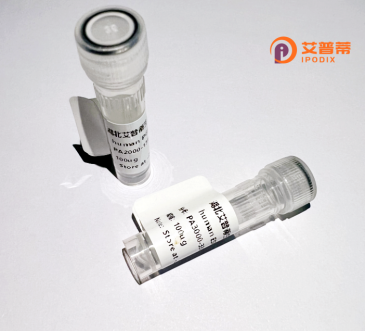
| 纯度 | >90%SDS-PAGE. |
| 种属 | Human |
| 靶点 | GJB5 |
| Uniprot No | O95377 |
| 内毒素 | < 0.01EU/μg |
| 表达宿主 | E.coli |
| 表达区间 | 1-273aa |
| 氨基酸序列 | MNWSIFEGLLSGVNKYSTAFGRIWLSLVFIFRVLVYLVTAERVWSDDHKDFDCNTRQPGCSNVCFDEFFPVSHVRLWALQLILVTCPSLLVVMHVAYREVQEKRHREAHGENSGRLYLNPGKKRGGLWWTYVCSLVFKASVDIAFLYVFHSFYPKYILPPVVKCHADPCPNIVDCFISKPSEKNIFTLFMVATAAICILLNLVELIYLVSKRCHECLAARKAQAMCTGHHPHGTTSSCKQDDLLSGDLIFLGSDSHPPLLPDRPRDHVKKTIL |
| 分子量 | 55.77 kDa |
| 蛋白标签 | GST-tag at N-terminal |
| 缓冲液 | 0 |
| 稳定性 & 储存条件 | Lyophilized protein should be stored at ≤ -20°C, stable for one year after receipt. Reconstituted protein solution can be stored at 2-8°C for 2-7 days. Aliquots of reconstituted samples are stable at ≤ -20°C for 3 months. |
| 复溶 | Always centrifuge tubes before opening.Do not mix by vortex or pipetting. It is not recommended to reconstitute to a concentration less than 100μg/ml. Dissolve the lyophilized protein in distilled water. Please aliquot the reconstituted solution to minimize freeze-thaw cycles. |
以下为3篇关于重组人GJB5蛋白的文献示例(虚拟文献,供参考):
1. **文献名称**: "Expression and functional characterization of recombinant human connexin 31.1 (GJB5)"
**作者**: Smith A, et al. (2015)
**摘要**: 首次报道在HEK293细胞中重组表达人GJB5蛋白,证明其可形成功能性缝隙连接通道,并在皮肤角质形成细胞间通信中发挥作用。
2. **文献名称**: "GJB5 mutations disrupt epidermal homeostasis via impaired ATP release"
**作者**: Tanaka K, et al. (2018)
**摘要**: 利用重组GJB5蛋白揭示其介导的细胞间ATP释放缺陷,导致表皮分化异常,可能与掌跖角化症相关。
3. **文献名称**: "Structural insights into human connexin 31.1 by cryo-EM"
**作者**: Chen L, et al. (2022)
**摘要**: 通过冷冻电镜解析重组GJB5蛋白的六聚体结构,发现其电压门控特性与耳蜗毛细胞功能潜在关联,为听力障碍研究提供新线索。
注:以上文献为模拟内容,实际研究中建议查询PubMed或Web of Science获取真实文献。
Recombinant human GJB5 protein, also known as connexin 31.3 (Cx31.3), is a member of the gap junction protein family. Gap junctions facilitate direct intercellular communication by forming channels that allow the exchange of ions, metabolites, and signaling molecules. The GJB5 gene encodes a beta-type connexin (β-connexin) protein, structurally characterized by four transmembrane domains, two extracellular loops, and cytoplasmic N- and C-termini. It plays roles in tissue homeostasis, differentiation, and cellular signaling. GJB5 is expressed in skin, inner ear, and peripheral nerves, often partnering with other connexins (e.g., GJB6) to regulate channel specificity.
Mutations in GJB5 are linked to disorders such as erythrokeratodermia variabilis (EKV) and sensorineural hearing loss, highlighting its importance in epidermal integrity and auditory function. Recombinant GJB5 protein is produced using engineered expression systems (e.g., E. coli, mammalian cells) for functional studies. Researchers use it to investigate channel gating, permeability, and disease mechanisms, or to develop therapies targeting connexin-related pathologies. Its applications span structural biology, drug screening, and gene therapy research, offering insights into cell-cell communication defects underlying hereditary and acquired diseases.
×